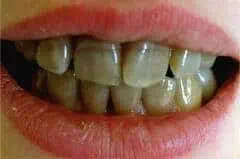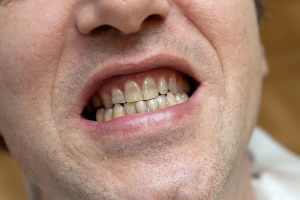Are you wondering what you can do about tetracycline teeth? This term refers to teeth that have noticeable discolouration and staining from use of the antibiotic tetracycline. The stains can be grey or brown in colour, often appearing in bands around the teeth. Fortunately, modern medical knowledge means that new cases are less common these days. But if you do have tetracycline teeth stains, they can make you quite self-conscious of how your teeth look.
So, can tetracycline-stained teeth be whitened?
More often than not, there are techniques that can be used to whiten tetracycline teeth, but sometimes, the condition of the teeth may be beyond whitening. In that case, there are various restorative procedures that can help.
In this article, we’ll explain how tetracycline teeth staining occurs and what you can do about it. We’ll also answer these questions:
- What are tetracycline teeth?
- What is the cause behind them?
- Does tetracycline cause tooth decay or any other side-effects?
- How do you whiten teeth damaged by this antibiotic?
We hope this helps you understand more about the condition and how to treat it.
In This Article
What is tetracycline?

Tetracycline is a strong antibiotic used to treat potentially life-threatening bacterial infections. Common applications include treatment of UTIs (urinary tract infections), respiratory tract infections, acne, gonorrhoea, and rosacea.
The tetracycline group of medications was discovered in 1945 and first administered in 1948. It was considered to be one of the most effective ways to treat bacterial infections, and before the 1980s, this antibiotic was often prescribed to patients suffering from such diseases. This included pregnant women and young children. At that time, medicinal science hadn’t fully decoded the side-effects of this drug, which include permanent staining or discolouration of teeth that are not fully developed (that is, in children who were younger than eight years of age).

Over time, as teeth staining was discovered in children taking this medicine, studies were conducted to conclude that tetracycline was causing the permanent staining of teeth. Later on, it was also found that the drug could cross placental barriers, meaning that if given to a pregnant woman, the effects of the drug were likely to cross over to the unborn child.
Since the discovery of this fact, various awareness programs have been conducted across the world to reduce the use of tetracycline. Consequently, there has been a significant decline in the occurrence of tetracycline staining. But even today, adults with tetracycline teeth can be spotted. If you come across someone with the condition, it probably means that they were prescribed the antibiotic when they were younger than eight years old.
Categories of tetracycline-stained teeth
Four categories of tetracycline teeth staining have been observed:
- Mild: This category materialises as minimal and uniformly distributed light yellow, light brown, or light grey stains restricted to the incisal part of the crown.
- Moderate: This is a slightly deeper staining that varies in location and quantity. Discolouration can range from deep yellow to grey or brown, but usually, there’s no banding.
- Severe: This is a more severe form of staining with dark brown, dark grey, or even blue and purple stains appearing on teeth, complete with banding.
- Intractable: This is the highest form of tetracycline staining observed to date, involving intense pigmentation of the teeth, including very dark stains and extremely pronounced bands.
While people may choose to live with mild or even moderate staining, living with severe and intractable cases of tetracycline teeth staining may be very challenging for self-esteem.
Factors that contribute to tetracycline tooth discolouration
The severity of teeth stains from tetracycline depends on the following factors:
- The medicine dose
- The length of treatment
- The stage of calcification of the child’s teeth
Though the staining can vary from yellow/grey to brown, most commonly, grey-coloured teeth are found in children taking this medicine. The discolouration can affect an entire tooth, or the stains can appear in the form of horizontal bands (like stripes) that range from light to dark.
Tetracycline staining differs from minocycline staining. Minocycline is a variant of the antibiotic and thus is also prescribed as a treatment for bacterial infections. Though it also causes teeth staining and discolouration to some extent, the effects of both drugs differ in that tetracycline-affected teeth give off a fluorescent yellow colour under UV light.

Additionally, permanent teeth display a more diffused and less intense discolouration than primary teeth.
You may be wondering why the teeth staining affects only children. The reason is that it is directly related to the process of calcification of teeth. Calcification of teeth starts even before we are born, during the second trimester of pregnancy, and continues up to the age of eight.
So if children whose teeth are still calcifying are exposed to tetracycline, the medicine attaches to the outside of the tooth, causing permanent staining. The exact location where tooth discolouration occurs directly correlates to the stage of tooth development at the time of the exposure.
Because doctors now understand what causes tetracycline teeth staining, they generally avoid prescribing this medicine to pregnant women and young children.
Does tetracycline stain teeth in adults?
Not often. Tetracycline causes permanent discolouration in children’s teeth because of the formation of insoluble calcium-tetracycline orthophosphate complexes in the dental enamel. These complexes darken on exposure to light, which leads to the grey or brown coloured teeth. The discolouration is less prominent in adults because of the lack of free calcium in the dental enamel. While that’s true, minocycline has been reported to cause teeth discolouration in 3 to 6% of adults who are on a daily dose of more than 100mg for over one month.
Therefore, although tetracycline staining is primarily observed in children, it may occasionally happen in adults as well, although it is fully reversible.
This fact has been demonstrated in this case where a 54-year-old woman suffered from brown-coloured staining on her teeth after taking a 4-week course of tetracycline medication for blepharitis. However, regular visitations to her dentist and an extensive abrasive cleansing treatment resulted in the complete removal of the staining.
Does tetracycline cause tooth decay?
Though most dental experts say the worst that tetracycline can do is permanently stain teeth in children, some believe the medicine can sometimes bind to the calcium phosphate in young children’s teeth and result in its absorption by the dental tissues.
This absorption can damage dental enamel of affected teeth and lead to pitting, increasing the risk of dental cavities. However, there are numerous other factors that are more likely to cause tooth decay in children.
Can tetracycline teeth be whitened?
Not always. Tetracycline stains are different from coffee, tea, and wine stains. Unlike the latter, which exist only on the surface of teeth, tetracycline stains are within the teeth (intrinsic). This means that the affected teeth cannot be whitened with products like toothpaste, strips and home whitening kits.
But that doesn’t mean it isn’t possible to get rid of tetracycline stains on teeth through whitening. Intrinsic professional teeth bleaching might be able to improve the appearance of teeth that are not too heavily discoloured. If you’re considering bleaching tetracycline-stained teeth, you will need to consult with a dentist to discuss your treatment options.
Alternatives to tetracycline whitening
In many cases, tetracycline teeth stains are too strong to respond well to whitening. Instead, teeth veneers or crowns can be very effective at covering the teeth and giving a much better aesthetic appearance.
In the video below you can see some tetracycline-stained teeth before and after veneers:
An alternative to porcelain veneers is composite bonding. The same material used in fillings is applied in a thin layer to the teeth. This procedure is cheaper than veneers, but not as durable or natural-looking.
The following table summarises the possible treatments to whiten teeth damaged by tetracycline:
Treatment | Description | Approximate cost |
Professional whitening | Bleaching agent used to whiten teeth from the inside | £500 - £1,500 |
Composite bonding | Filling material applied to cover stained tooth | £100 - £400 per tooth |
Porcelain veneers | Thin porcelain cover applied to front of tooth | £400 - £1,000 per tooth |
Crowns | Whole tooth capped with porcelain or another material | £400 - £800 |
If the cost of veneers or crowns seems too high, consider visiting a dentist abroad to save 50-70% on your treatment.
Conclusion
People living with tetracycline teeth stains often avoid smiling and suffer from low self-esteem. Understanding the causes and treatment for tetracycline stained teeth could form an essential step in accepting the problem and looking for a solution.
If this condition is affecting you, speak to a dentist about your treatment options. Bleaching, veneers and crowns can all help to whiten teeth damaged by tetracycline and transform your confidence in your smile. The right one for you will depend on the degree of tooth discolouration, your budget, and the general condition of your teeth.
ncbi.nlm.nih.gov: Tetracycline-Induced Discoloration of Deciduous Teeth. Consulted 4th March 2020.
ebmconsult.com: The Mechanism for Tetracycline Associated Staining of the Teeth. Consulted 4th March 2020.
nature.com: Reversible tetracycline staining of adult dentition in the treatment of chronic blepharitis. Consulted 4th March 2020.
sciencedaily.com: Tetracycline Plus Teeth Equal Gray Smile. Consulted 4th March 2020.
oralhealthgroup.com: Treatment of Tetracycline Discoloured Teeth with Full Ceramic Restorations. Consulted 4th March 2020.
patientconnect365.com: Combating Tetracycline Stains. What Works?. Consulted 4th March 2020.




